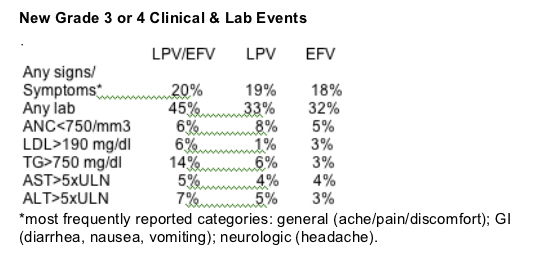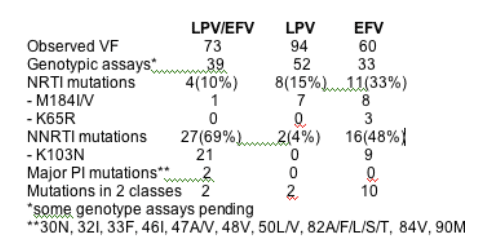 |
 |
 |
| |
Kaletra, Efavirenz, and Kaletra+Sustiva Compared (ACTG 5142)
|
| |
| |
A Prospective, Randomized Phase III Trial of NRTI-, PI-, and NNRTI-sparing Regimens for Initial Therapy of HIV-1 (ACTG 5142)
Reported by Jules Levin
XVI Intl AIDS Conference
Toronto, Aug 17, 2006
Sharon Riddler reported the study results in the oral Late Breaker session this afternoon. There were 18 oral presentations in this long, tiring, jam-packed session, so each talk could only have 7 minutes. I've never experienced an oral session with 18 presentations, too much. In addition, this conference was disorganized and distressed many of the attendees for numerous reasons.
Brief Summary by Jules Levin: this study compared a Sustiva+ 2 nukes regimen to a Kaletra+ 2 nukes regimen, and it also compared these 2 regimens to a regimen of only Kaletra+Efavirenz without nukes. In this study the Kaletra+EFV regimen was less successful than the other 2 regimens in that patients on this regimen developed more resistance mutations when they developed viral rebound & they had more side effects and lab abnormalities. This study was designed several years ago so it did not use the new Kaletra once a day tablets. The study compared Efavirenz to the older Kaletra capsules (soft-gel capsules) taken twice a day. The new formulation of Sustiva (efavirenz) is Atripla (one pill once a day) and this was not used either in this study. So what were the results of this study in brief: the EFV regimen was more potent in that 89% achieved <50 copies/ml at week 96 compared to 77% for Kaletra and 83% for Kaletra+EFV. The time to viral failure was shorter for the Kaletra+2 nukes group compared to the EFV+2 nukes. The proportion not failed at week 96 was 73% for Kaletra+EFV, 67% for Kaletra+2 nukes, and 76% for EFV+2 nukes. You can look at the table in the article to see the Grade 3 & 4 clinical & lab adverse events and the incidence was fairly similar for patients taking Kaletra or EFV regimens but not as good for patients taking Kaletra+EFV. The CD4 increase from baseline to week 96 was higher for the Kaletra group and for the Kaletra+EFV group compared to the EFV group. The EFV +2 nukes group developed more drug resistance mutations than the Kaletra group at the time of viral failure. Since this was the first report of results from this study we can expect more information from the study investigators to be reported.
ACTG 5142 is a multi-center open-label randomized 96-week study of 753 ARV-naive patients with >2,000 HIV RNA c/ml and with any CD4 count. Patients received one of three regimens: Kaletra (LPV/r, soft-gel capsules) 533/133 mg bid+Efavirenz 600 mg qd, or LPV/r (soft-gel capsules) 400/100 mg bid + 2 NRTIs, or EFV 600 mg qd + 2 NRTIs. So, the new formulations of Atripla and Kaletra once daily tablets were not studied in this trial. The 2 nukes included 3TC plus investigator selection of AZT or d4T-XR or TDF. Responses were stratified by HIV-RNA >100,000 c/ml, hepatitis infection, and selection of NRTI.
PRIMARY OBJECTIVES
To compare, pairwise between arms, time to virologic failure:
--defined as early: lack of suppression by 1 log or rebound before week 32;
--or late: failure to suppress to <200 copies/ml or rebound after week 32.
To compare, pairwise between arms, time to regimen completion:
--regimen completion defined as virologic failure or toxicity related discontinuation of any regimen component.
STATISTICAL ANALYSIS
Data are updated from the published abstract.
ITT.
Significance threshold for the primary endpoints= 0.016 adjusted for:
- 2 co-primary endpoints
- 3 pairwise comparisons
- interim analysis
Subjects with RC due to toxicity followed for VF for the remainder of the study.
Subjects who discontinued without reaching a primary endpoint were censored.
BASELINE CHARACTERISTICS
The 3 groups appeared comparable at baseline.
There were 250 patients in each group.
Females: 18-23%.
Non-whites: 60-65%.
Median age: 37-39.
Median CD4: 178-190.
HIV-RNA >100,000: 51-52%
Selected NRTI
AZT: 42%
D4T-XR: 24-25%
TDF: 34%
TIME TO VIROLOGIC FAILURE
The median follow-up was 112 weeks. The time to virologic failure was significantly shorter in the LPV + 2 NRTI arm as compared to the EFV + 2 NRTI arm, said Riddler. The proportion not failed at week 96: LPV/EFV: 73%; LPV: 67%; EFV: 76%. On the graph the LPV curve appeared clearly separated from the EFV curve by week 48.
Adjusted p values (threshold for significance <0.016)--
LPV/EFV vs LPV: 0.13
LPV/EFV vs EFV: 0.5
LPV vs EFV : 0.006
TIME TO REGIMEN COMPLETION
There was a trend towards shorter time to regimen completion for the LPV + 2 NRTI arm compared to the EFV + 2 NRTI arm, with a p-value of 0.02, which does not reach the significance threshold.Proportion not failed at week 96:
LPV/EFV: 61%; LPV: 54%; EFV: 60%.
Adjusted p values (threshold for significance <0.016)-
LPV/EFV vs LPV: 0.13
LPV/EFV vs EFV: 0.5
LPV vs EFV: 0.02
TIME TO FIRST TREATMENT LIMITING TOXICITY
There was no difference in time to first treatment limiting toxicity between the 3 arms.
LPV/EFV vs LPV: 0.6
LPV/RFV vs EFV: 0.5
LPV vs EFV: 0.9

Proportion with HIV-RNA <200 copies/ml
(Intent To Treat, Missing values ignored)
At week 96, the proportion of patients with <200 c/ml is 92% for LPV/EFV, 86% for LPV, and 93% for EFV. The difference between the EFV and LPV arms is significant, Riddler said, with a p-value of 0.041.
Proportion with HIV-RNA <50 copies/ml (ITT, Missing values ignored)
At week 96, the prportion of patients with <50 c/ml is 89% in the EFV arm, 83% in the LPV/EFV arm, and 77% in the LPV arm. Riddler said there is a significant difference between LPV and EFV with a p-value of 0.003.
Median CD4 Change from Baseline
At week 96 there was a significantly higher median increase in CD4 cells for the two LPV regimens each compared to the EFV regimen, p-values of 0.01 for each comparison.
Median Change:
LPV/EFV: +268
LPV: +285
EFV: +241
Preliminary Summary of Drug Resistance Mutations
At the present time there is genotypic resistance data for 124 of the 227 subjects at the time of virologic failure.

Author Conclusions:
Compared with a regimen of EFV+NRTI, LPV+2 NRTIs had a significantly shorter time to virologic failure and tended to have a shorter time to regimen completion. (Again, the soft-gel formulation of Kaletra was used, not the new tablet which is once a day).
The NRTI-sparing regimen of LPV+EFV had similar virologic efficacy and similar time to treatment limiting toxicity as EFV+2 NRTI.
Preliminary resistance analyses show a trend toward more NNRTI resistance in the LPV/EFV arm compared with EFV + 2 NRTI.
Resistance mutations in 2 drug classes (M184I/V+K103N) were more common in the EFV + 2 NRTI arm. Major mutations were rare.
|
| |
|
 |
 |
|
|